Don’t Just Shoot: Learn
If you are interested in changing your life and becoming a better photographer by joining me on an Extended IPT at Sebastian Inlet for Ospreys and more (SEPT 25 to NOV 24, 2025) or in San Diego for Pacific-race Brown Pelicans and more (JAN 6 to FEB 2, 2026), please e-mail for dates, rates, terms, and additional information. Or, shoot me a text to 863-221-2372. Both offerings include options for shared AirBnB lodging and ground transportation during your stay.
Your Call
Which of today’s six featured extreme images is your favorite? Why did you make your choice?
In the Last Blog Post
In the last blog post, Going to Extremes, here, I asked “Which of today’s three featured extreme images is your favorite. Why did you make your choice? Which one do you consider the most extreme? Why?”
Thanks to the many who left comments. My favorite image was Anita’s wide angle crane family image because of its uniqueness. Who would think to try to photograph a crane family with a wide angle zoom lens? Here was also the most extreme for me for the same reason. That said, I was thrilled to get one sharp one of the Anhinga with the bass and loved creating the preening spoonbill image hand held at 1120mm with the 400-800 and the 1.4X TC.
What’s Up?
As always, the rookery at St. Augustine Alligator Farm (and all other rookeries, as well), is a very tough place to shoot: clutter, whitewash, and tough shooting angles. And all of those problems are exacerbated when the sun is shining. Yikes. I almost forgot the wires that have been installed above the top of the boardwalk railing. More on those when I post some images.
Pat Fishburne joined me for an In-the-Field Session and we worked on dealing with everything above. In addition, we went over the shutter speed basics for her when hand holding her Sony 300mm f/2.8 GM lens (with and without the 1.4X TC). I added that primer to the Sony 300mm Lens Guide along with several dozen new images. I still have a few days work to do before I start on the 400-800 guide. Big time thanks to Paul Sher who ordered his 4-8 with Bedford yesterday.
Today is Thursday 10 April 2025 and I will be headed back to the rookery boardwalk early this morning to look for some more neat birds and some cool shooting angles. Whatever you plan on doing, I hope that you too opt to have a wonderful day. Do remember that happiness is a choice — Byron Katie, The Work.Com.
If an item — a Delkin flash card, or a tripod head — for example, that is available from B&H and/or Bedfords, is also available in the BAA Online Store, it would be great, and greatly appreciated, if you would opt to purchase from us. We will match any price. Please remember also to use my B&H affiliate links or to earn 3% cash back at Bedfords by using the BIRDSASART discount code at checkout for your major gear purchases. Doing either often earns you free guides and/or discounts. And always earns my great appreciation.
Indian Lake Estates BAA Baby Crane In-the-Field Sessions
I am currently available for morning BAA Baby Crane In-the-Field sessions on the following dates: April 12-17, 19-24, & 29-30. The first half of May should be ideal as well. Please e-mail for costs and additional information. Or, shoot me a text to 863-221-2372.
|
|
|
This image was created down by the lake near my home at Indian Lake on 8 April 2025 on a BAA Baby Crane In-the-Field instructional session with Joe Norton. Crouching a bit and working off the tilted rear monitor, I used the hand held Sony FE 300mm f/2.8 GM OSS Lens (Sony E) and The Latest Greatest Sony Flagship Body, the a1 II Mirrorless Camera. ISO 12,800. Exposure determined via Zebras with ISO on the Thumb Wheel; 1/250 sec. at f/2.8 (wide open) in Manual mode. RawDigger showed that the exposure was dead solid perfect: AWB at 7:29:05am on a cloudy, overcast, sometimes drizzly morning. Wide/AF-C with Bird Eye/Face Detection enabled performed perfectly. Image #1: Sandhill Crane chick body shot |
A Brilliant Move and a Huge Success
Accomplished shooter Joe Norton signed up for a Stick Marsh In-the-Field session for Tuesday 8 April but I got in touch with him on Monday and let him know that the weather forecast for Fellsmere and the spoonbills was terrible — cloudy dark with drizzle. I suggested that we meet at Indian Lake Estates and do the baby cranes instead. He jumped at the chance and was glad that he did. He was astounded when we sat on the wet grass and two of the five crane families, those with the 1-day old chicks, walked right up to us.
To deal with the extreme low light conditions, we both went with our Sony a- ii bodies and our 300mm f/2.8 lenses. That done, we began using ridiculously high ISOs. From where I sit, Image #1 made at ISO 25,800, looks quite acceptable in all regards including noise.
|
|
|
This image was created down by the lake near my home at Indian Lake on 8 April 2025 on a BAA Baby Crane In-the-Field instructional session with Joe Norton. Crouching a bit and working off the tilted rear monitor, I used the hand held Sony FE 300mm f/2.8 GM OSS Lens (Sony E) and The Latest Greatest Sony Flagship Body, the a1 II Mirrorless Camera. ISO 5,000. Exposure determined via Zebras with ISO on the Thumb Wheel; 1/250 sec. at f/2.8 (wide open) in Manual mode. RawDigger showed that the exposure was dead solid perfect: AWB at 7:31:17 am on a cloudy, overcast, sometimes drizzly morning. Wide/AF-C with Bird Eye/Face Detection enabled performed perfectly. Image #2: Photographer Joe Norton and pair of crane chicks |
Too Close to Focus
Here, two 10-day old chicks walk within six feet of Joe who is crouching steeply on the bank that leads down to the South Canal.
Via Text from Joe Norton
Art, thanks so much for sharing your Sandhill Crane Colts with me at Indian Lake yesterday morning. It was a blast! Can’t wait to slowly review all the images when I get home. I safely made it to Cordele, GA last night, and begin the second leg of my trip home shortly which will take me to Paducah, KY.
|
|
|
This image was created down by the lake near my home at Indian Lake on 8 April 2025 on a BAA Baby Crane In-the-Field instructional session with Joe Norton. Working from well down on the slope that leads to the canal, I used the hand held Sony FE 300mm f/2.8 GM OSS Lens (Sony E) and The Latest Greatest Sony Flagship Body, the a1 II Mirrorless Camera. Exposure determined via Zebras with ISO on the Thumb Wheel. ISO 2500: 1/500 sec. at f/2.8 (wide open) in Manual mode. RawDigger showed that the exposure was dead solid perfect: AWB at 7:56:23am on a cloudy, overcast, sometimes drizzly morning. Wide/AF-C with Bird Eye/Face Detection enabled performed perfectly. Image #3: Sandhill Crane chick twins |
Autofocus Problem Leads to Fine Result
When the two chicks posed near momma’s legs as dad flew off to tilt at windmills, I framed the shot. Though it was slightly farther away, I wanted the bird between the adult’s leg sharp. While using Wide, however, I noticed that the AF point was going from the eye of one chick to the eye of the other. I grabbed the sharp chick on our right and the adult’s leg and belly using a Quick Mask, brought it into the image with the chick on our left sharp, positioned it carefully, warped the selection a bit using the Transform Command, and refined the mask using a Regular Layer mask. The result — a somewhat crude form of focus stacking that produced an image with two razor sharp chicks. That despite the fact that they were on different planes at the moment of exposure.
Confused by the above? Learn it all and tons more in Digital Basics II and in the Digital Basics III Video Series.
|
|
|
This image was created down by the lake near my home at Indian Lake on 8 April 2025 on a BAA Baby Crane In-the-Field instructional session with Joe Norton. Crouching a bit and working off the tilted rear monitor, I used the hand held Sony FE 300mm f/2.8 GM OSS Lens (Sony E) and The Latest Greatest Sony Flagship Body, the a1 II Mirrorless Camera. Exposure determined via Zebras with ISO on the Thumb Wheel. ISO 3200: 1/500 sec. at f/2.8 (wide open) in Manual mode. RawDigger showed that the exposure was dead solid perfect: AWB at 8:05:36am on a cloudy, overcast, sometimes drizzly morning. Wide/AF-C with Bird Eye/Face Detection enabled performed perfectly. Image #4: Sandhill Crane chick standing tall |
Hating Sitting on Wet Grass
To avoid sitting down on the wet grass and having to get back up off the ground again, I used the vertical tilt screen while holding the camera down at thigh levels. Note that as this is not the most stable of hand held shooting methods, I raised the shutter speed from 1/250 to 1/500 second to ensure a sharp result.
|
|
|
This image was created down by the lake near my home at Indian Lake on 8 April 2025 on a BAA Baby Crane In-the-Field instructional session with Joe Norton. Crouching a bit, I used the hand held Sony FE 300mm f/2.8 GM OSS Lens (Sony E) and The Latest Greatest Sony Flagship Body, the a1 II Mirrorless Camera. Exposure determined via Zebras with ISO on the Thumb Wheel. ISO 3200: 1/640 sec. at f/2.8 (wide open) in Manual mode. RawDigger showed that the exposure was dead solid perfect: AWB at 8:32:33am on a cloudy, overcast, sometimes drizzly morning. Wide/AF-C with Bird Eye/Face Detection enabled performed perfectly. Image #5: Sandhill Crane chick with foot raised in a light drizzle |
Working Down the Slope
By making my way down the slope that leads to the South Canal, I am able to get at eye level with the crane chicks. As we have seen here previously on many occasions, the single raised foot is a huge plus.
|
|
|
This is a 100% crop of Image #5A. Image #5A: Rain droplets on the head of the Sandhill Crane chick in the previous image |
A 100% Crop
To me, the sharpness of the water droplets — AKA light rain — is wonderful. Especially since the wide open aperture of f/2.8 was used.
|
|
|
This image was created down by the lake near my home at Indian Lake on 8 April 2025 on a BAA Baby Crane In-the-Field instructional session with Joe Norton. Seated in the driver’s seat of my SUV (Joe was right behind me), I used the BLUBB-supported Sony FE 600mm f/4 GM OSS lens with The Latest Greatest Sony Flagship Body, the a1 II Mirrorless Camera. Exposure determined via Zebras with ISO on the Thumb Wheel. ISO 2500: 1/800 sec. at f/4 (wide open) in Manual mode. RawDigger showed that the exposure was dead solid perfect: AWB at 8:53:43am on a cloudy, overcast, sometimes drizzly morning. Wide/AF-C with Bird-Eye/Face Detection performed perfectly. Click on the image to enjoy the larger, inexplicably sharper high-res version. Image #6: Sandhill Crane colt about 7 weeks of age |
The Elusive Colt
This is the colt that survived for three weeks unseen by me. I was shocked two weeks ago when I saw it at the south end of the South Peninsula, looking fit and healthy. Joe and I got to photograph it out in the open for the first time since I relocated it. Anita was envious. It is one shy guy. Or gal.
Typos
With all blog posts, feel free to e-mail or to leave a comment regarding any typos or errors.

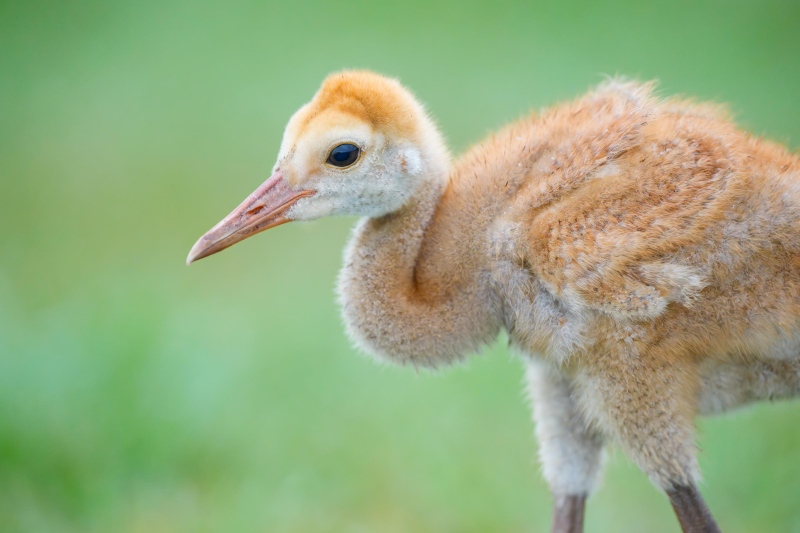
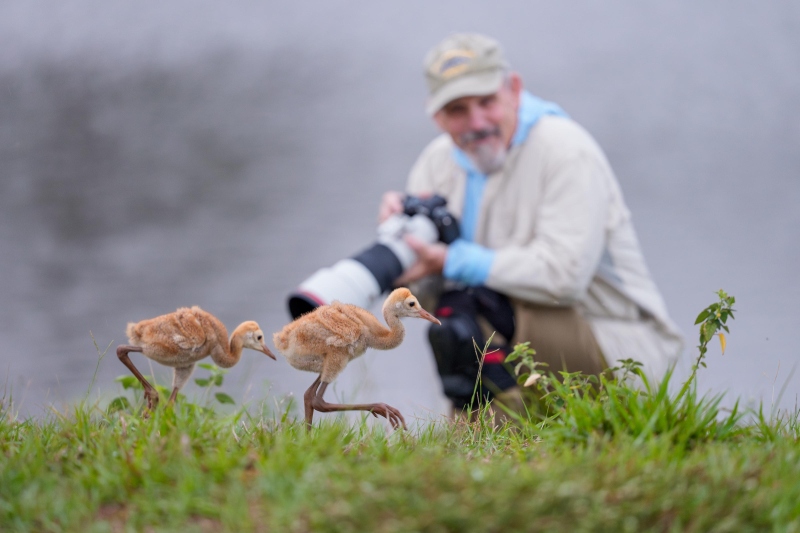
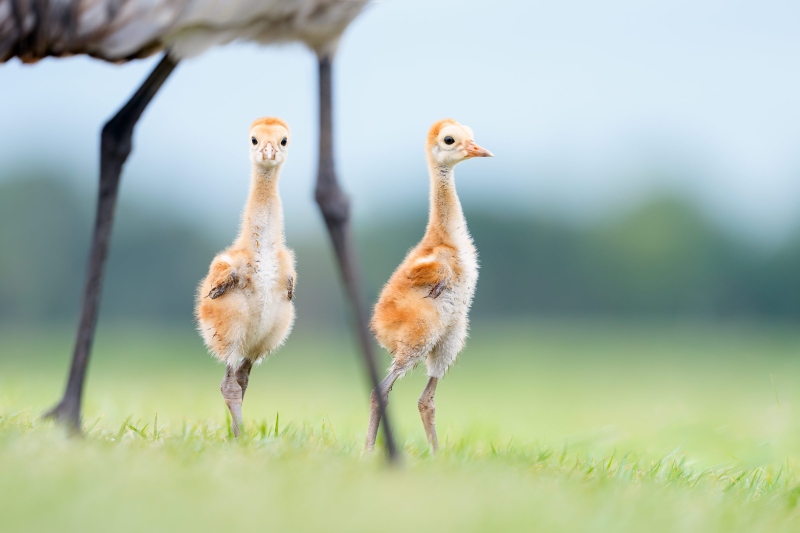
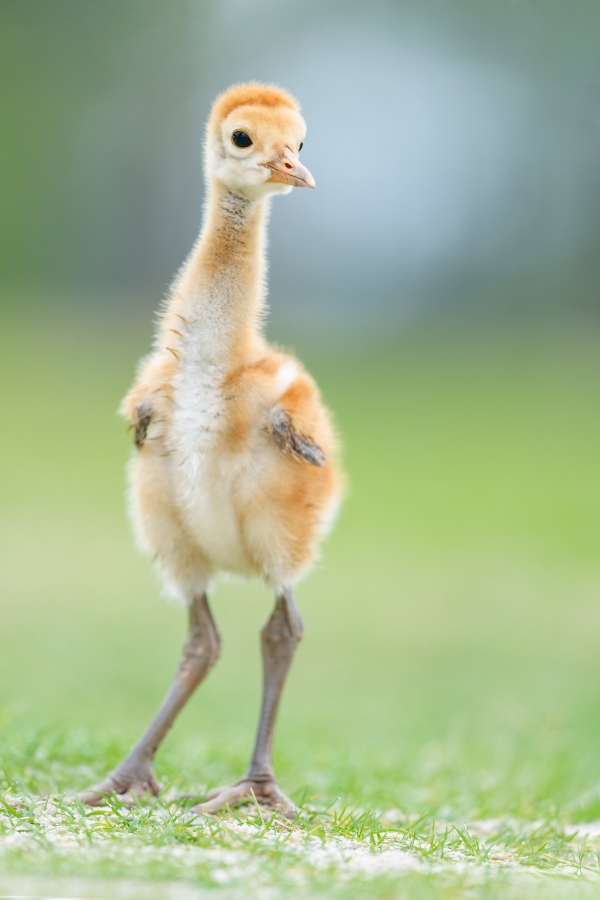
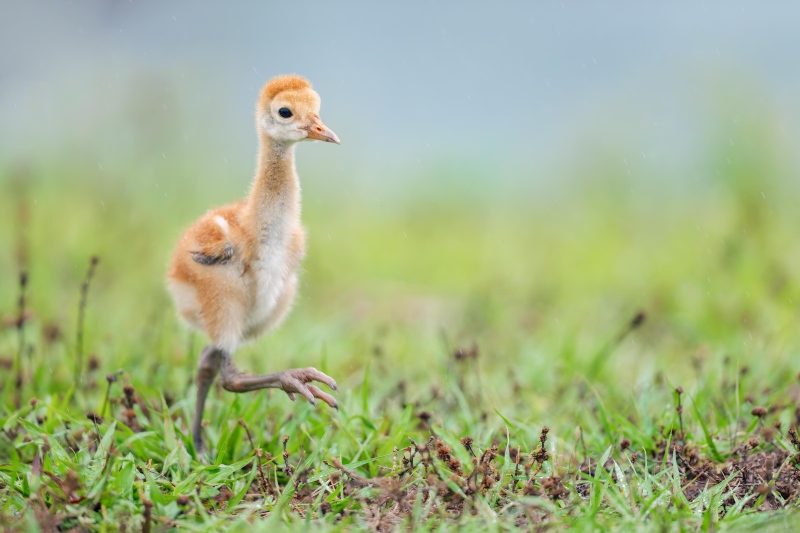
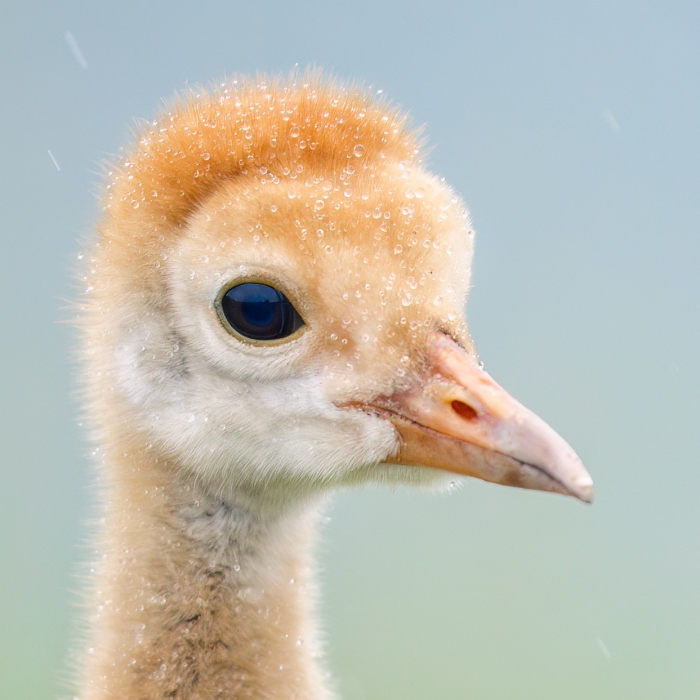
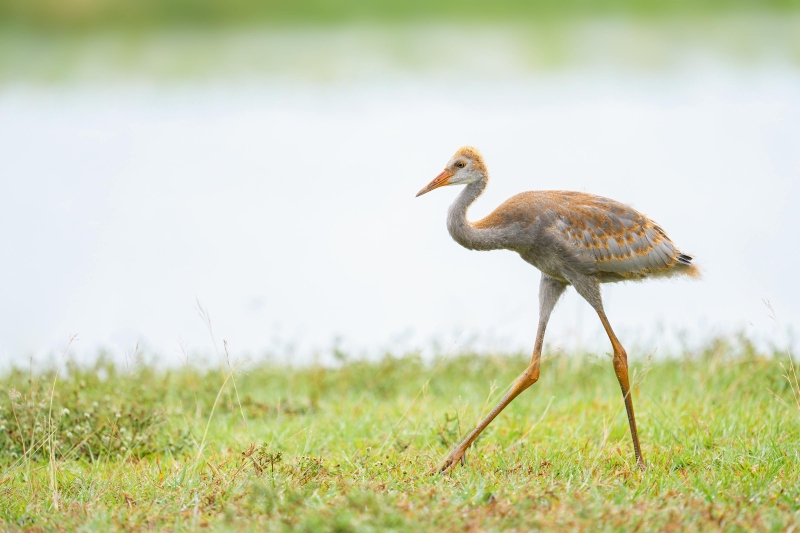









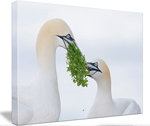



Image #5A is my favourite — I really like the fine details and the way it’s cropped.
My favorites are 3, 4, 5, and 6, with 6 possibly my most favorite. The water drops on that already wonderful portrait take it to another level.
All solid (of course), including the shot of Joe with the colts, but Image 3 is strongest for me too–the low angle and above tree line heads give it the same sort of appeal that Anita’s wide-angle shot has. Smart move on the two-frame focus stacking–I’ve done that too, including with a crane pair.
Thanks, Cliff. Any port in a storm 🙂
a
#3. The mother is actually in front of the babies, but when stepping back and veiwing as a whole, she appears to be hovering above and therefore behind the babies. Interesting, I really like it.. Eventhough the ISO is not high at all on that one. 2500 cleans up nice. likewise on #5 water drops at 3200.
Something strange on #1. 12,800 should be better than that, but at 1/250 sec you are limited with any motion (you crouching on rear monitor or the bird moving).
Thanks, AA. Yes. The adult was in front of the two chicks.
With #1, what are you seeing in #1 that you do not like? Me thinks that it might be a depth of field issue because I was so close …
with love, a